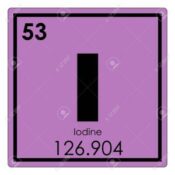The Colors of Iodine
Updated December 2, 2022

Iodine Program
Iodine can generate several colors
First, it can be clear, in the iodide form, when bound to certain molecules, such as ascorbate in an acidic medium.
Second, it can be yellow brown, when in the I3- form, in water (such as Lugols) or alcohol (Tincture)
Third, it can be purple or blue-black, when interacting with starches (I5!, a combo of I2 and I-, a way of testing for oxidation). The vapor phase of iodine is also purple. In the presence of amylose, it becomes blue-black; With amylopectin it becomes a pale purple-red.
Fourth, it can be pink, when complexed with H2O2 and other agents.
Fifth, it can produce red, as in the coloring Red #3, which contains iodine (yet toxic due to its chemical structure).
Iodine Test Paper
Iodine Mixtures Can Change Color over 1 Hour!

This page is under development. Working links will provide starting information. Please let us know about your interest in this page by emailing us here, and check back soon.

